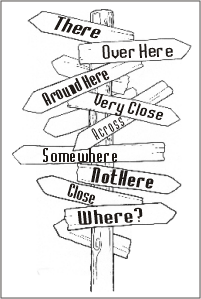| READING
ASSIGNMENT: Click
here for Chapter 1
 You
have had the opportunity in previous research to identify an ancestor
in the United States. Perhaps you have actually traced an ancestor
to the place he or she arrived in America, and thereby encountered
so many individuals with the same name that you could not tell who
the proper ancestor is. You
have had the opportunity in previous research to identify an ancestor
in the United States. Perhaps you have actually traced an ancestor
to the place he or she arrived in America, and thereby encountered
so many individuals with the same name that you could not tell who
the proper ancestor is.
The purpose of this lesson is to fortify you with the proper tools
to identify your immigrants in their home towns when the number
of similar named individuals will be much larger. We will also work
on how to identify the home town, itself in later lessons. This
week, you will learn how historians use key information as identifiers
to be certain they are discussing the same person in various time
periods in various locations.
Chapter One in your text cover the necessity of learning four facts
for each of your immigrant ancestors:
1. First you need to know the name of the immigrant.
You were warned that this may not be easy since some families
only have a vague tradition about their original immigrant. Some
immigrants changed their names or recorders Anglicized their names
when they came to this new country. We need to determine the complete
foreign version of your immigrant ancestor's name. Let us use
Scotland as an example. Many people find their Scottish name on
a Sept list. The term Sept comes from the Irish language and has
a connotation similar to clan. It is subject to some debate because
most of these lists have been the creation of businessmen who
attempt to sell information or mementos such as tartans or coats
of arms. While these lists might help you find a large area of
interest in your name like associations from phone books, you
will need much more to find your ancestor.
2. You need the date of an event that happened
to your immigrant ancestor in the old country. Birth dates are
preferred, but a marriage in a foreign country or other events
will often get you off and running. That date needs to be as specific
a date as possible, including the day, month, and year, not just
an approximate date. For example, the Irish are very casual about
their birth date and thus you may find that it changes from census
to census, or on other records such as an age at marriage, and
an age at death. But perhaps you are able to find the actual birth
date of a sibling who was known to be older than your ancestor.
This date can be used as compass point for other family members.
Watch carefully for all family members.
3. Next you need to learn the name of a relative
affiliated (connected) with the ancestor in the old country. A
marriage record might give a father’s name in the old country.
A probate might list a cousin, uncle, or grandparents in the old
country. A bank record might leave the name of an heir in the
old country.
4. Lastly, you need the place of origin. Like
the date, this needs to be as specific as possible. Records in
your ancestor's countries were kept at a local level. There are
virtually no nation-wide indexes in foreign countries. This fourth
fact is usually the most difficult for family historians to obtain.
For example, a person had a tradition of a Scottish ancestor who
came in the 1700s to America. The family had in their traditions
that they came from Aberdeenshire. Upon researching the family,
it was discovered that the family had been transplanted from Aberdeenshire
to County Down in Northern Ireland nearly two hundred years before
immigrating to New York State. From New York State, the majority
of the family had moved to Canada for two generations before returning
to the United States. In Toronto, it was more acceptable to be Scottish
so the Irish generations faded from the memories of the descendants.
These lessons will provide you with tools to work your way through
such a maze.
Much of our focus for a couple of months will be on methods and
sources for learning this elusive fourth fact but there are additional
facts that can assist you in identifying your ancestor. Before we
continue, however, take out a piece of paper or pull up a computer
notepad and jot down what you currently know about your immigrant
ancestors four identifiers as mentioned above.
|
 You
have had the opportunity in previous research to identify an ancestor
in the United States. Perhaps you have actually traced an ancestor
to the place he or she arrived in America, and thereby encountered
so many individuals with the same name that you could not tell who
the proper ancestor is.
You
have had the opportunity in previous research to identify an ancestor
in the United States. Perhaps you have actually traced an ancestor
to the place he or she arrived in America, and thereby encountered
so many individuals with the same name that you could not tell who
the proper ancestor is.